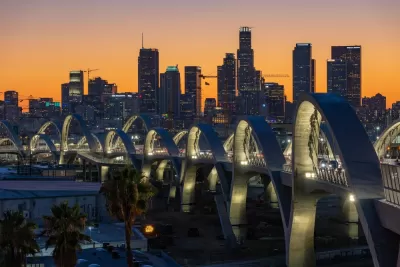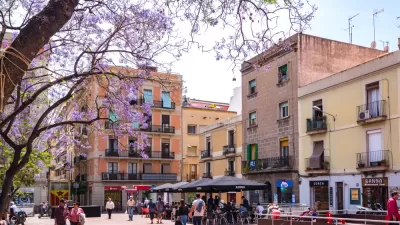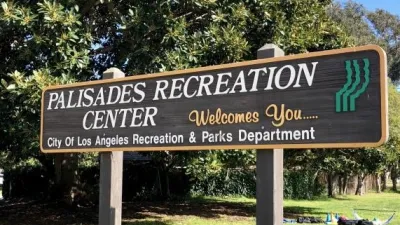Could the chaos that has plagued the 6th Street Viaduct’s first few weeks signal an opportunity to reimagine its intended uses?

Two weeks after its much-anticipated public opening, L.A.’s 6th Street Viaduct is closed. As Andy Kalmowitz reports in Jalopnik, the closure is “largely due to a near constant stream of illegal activity from drivers taking over the brand-new, $588 million bridge in downtown L.A.”
After a series of temporary closures, the city is installing speed bumps in order to discourage street racers and other reckless drivers. “Along with the new speed bumps, the city is installing a center median divider as well as fencing to discourage people from scaling the archways, which is just one more baffling thing people have been doing on the bridge.”
Even before its reconstruction, the 6th Street bridge was a famous backdrop. “The original bridge the Viaduct replaces was an iconic LA landmark, seen in movies like Grease and Terminator 2: Judgement Day. The new bridge wasted no time making a name for itself, clearly.”
The Los Angeles Times editorial board, meanwhile, recently advocated for closing the bridge to cars altogether.
The board argues that the bridge could become a West Coast version of New York City’s High Line, literally and figuratively elevating people over cars. “Despite less than ideal conditions (the speeding cars and the flimsy “protected” bicycle lanes), the 6th Street Viaduct has become a spot for family strolls, bike rides, scenic views, even quinceañera photos and a podcast recording. This is no mere roadway connecting Boyle Heights and downtown. It’s an opportunity to rethink L.A. transportation infrastructure and public space.”
FULL STORY: LA's Half-a-Billion-Dollar Bridge Shut Down After Just 2 Weeks

Alabama: Trump Terminates Settlements for Black Communities Harmed By Raw Sewage
Trump deemed the landmark civil rights agreement “illegal DEI and environmental justice policy.”

Planetizen Federal Action Tracker
A weekly monitor of how Trump’s orders and actions are impacting planners and planning in America.

The 120 Year Old Tiny Home Villages That Sheltered San Francisco’s Earthquake Refugees
More than a century ago, San Francisco mobilized to house thousands of residents displaced by the 1906 earthquake. Could their strategy offer a model for the present?

In Both Crashes and Crime, Public Transportation is Far Safer than Driving
Contrary to popular assumptions, public transportation has far lower crash and crime rates than automobile travel. For safer communities, improve and encourage transit travel.

Report: Zoning Reforms Should Complement Nashville’s Ambitious Transit Plan
Without reform, restrictive zoning codes will limit the impact of the city’s planned transit expansion and could exclude some of the residents who depend on transit the most.

Judge Orders Release of Frozen IRA, IIJA Funding
The decision is a victory for environmental groups who charged that freezing funds for critical infrastructure and disaster response programs caused “real and irreparable harm” to communities.
Urban Design for Planners 1: Software Tools
This six-course series explores essential urban design concepts using open source software and equips planners with the tools they need to participate fully in the urban design process.
Planning for Universal Design
Learn the tools for implementing Universal Design in planning regulations.
Clanton & Associates, Inc.
Jessamine County Fiscal Court
Institute for Housing and Urban Development Studies (IHS)
City of Grandview
Harvard GSD Executive Education
Toledo-Lucas County Plan Commissions
Salt Lake City
NYU Wagner Graduate School of Public Service





























